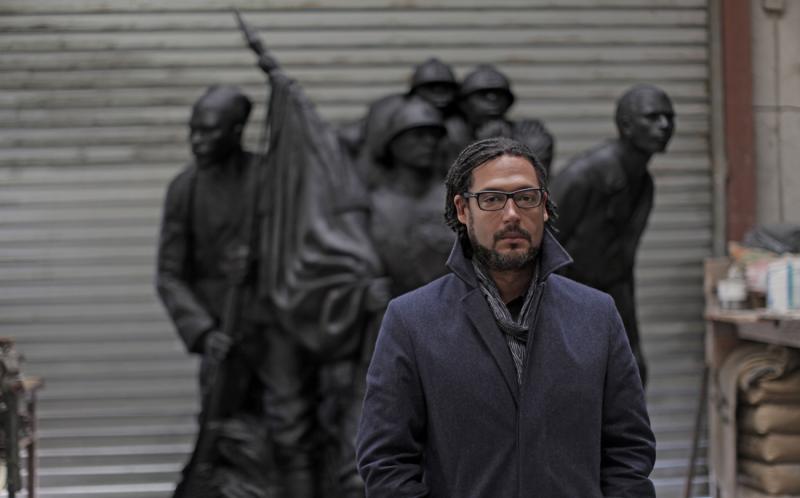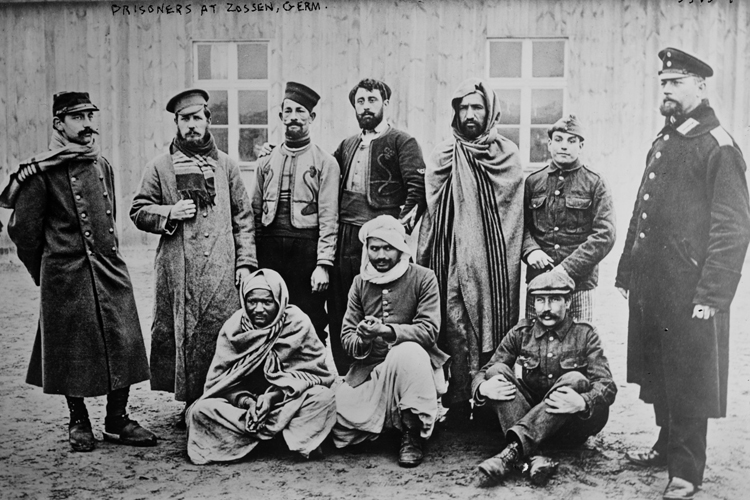The World's War: Forgotten Soldiers of Empire, BBC Two | reviews, news & interviews
The World's War: Forgotten Soldiers of Empire, BBC Two
The World's War: Forgotten Soldiers of Empire, BBC Two
How colonial troops were thrown into the blood and horror of the Western Front

We call it the First World War, but in Western Europe at least, most of the scrutiny is confined to what happened to Britain, France and Germany (with a side order of Russia) from 1914-18.
Beginning with the revelation that the first shot fired by the British Army after the declaration of war in August 1914 was from an African soldier of the British West African Frontier Force in an attack on German forces in Togoland, Olusoga swept across the battlefields of France and Belgium, but also probed skilfully into the mysteries of the imperial mindset. This was crammed with weird notions about race and fighting spirit (it was a place where "the madness of war is overlaid with the craziness of racial prejudice," as Olusoga put it).
 We learned how the British Army in India was keen on the "Theory of the Martial Races", and such experts as Lt Col JWB Merewether enumerated the attributes of the various Indian peoples in the way he might have assessed racehorses or bloodhounds. The Jats (from the Punjab) were a tough and durable "thoroughbred race", the Pathans were "handsome" and "athletic", and the Gurkhas were cheery, adaptable and friendly. Naturally all of them would need the firm guiding hand of white British officers (colonial prisoners held by the Germans at Zossen, pictured above).
We learned how the British Army in India was keen on the "Theory of the Martial Races", and such experts as Lt Col JWB Merewether enumerated the attributes of the various Indian peoples in the way he might have assessed racehorses or bloodhounds. The Jats (from the Punjab) were a tough and durable "thoroughbred race", the Pathans were "handsome" and "athletic", and the Gurkhas were cheery, adaptable and friendly. Naturally all of them would need the firm guiding hand of white British officers (colonial prisoners held by the Germans at Zossen, pictured above).
At the start of the war, the British were desperately short of professional fighting men, and the contribution of the Indian corps proved critical in stemming the German onslaught at Ypres, though photographs of the Indians enduring the freakishly cold winter of 1914 were pitiful to behold. They also came close to achieving a potentially war-winning breakthrough at Neuve Chapelle. Olusoga had unearthed a cache of letters written by the troops, in which they used imagery of their former faraway rural life to describe this hideous technological carnage - "men are dying like maggots... none can count them", "the corpses cover the country like sheaves of harvested corn." By the end of 1915, they'd suffered so many casualties and lost so many officers that they were transferred to the Middle East.
 Meanwhile the French were somewhat schizophrenic about their own colonial troops (many of them from West Africa, grouped under the collective heading of "tirailleurs Sénégalais"). Though the so-called "Force Noire" performed such feats as helping to recapture the Douaumont fort at Verdun, and were fêted with jingoistic fervour by the French press ("un Noir vaut deux Boches"), the French establishment was disturbed by lingering folk myths depicting the Africans as priapic savages liable to run amok in the jardins of the bourgeoisie. The soldiers were therefore taught only a minimalist, baby-talk French, and were groomed to behave like "the loyal simpleton soldier", as historian Alison Fell put it (a Senegalese tirailleur, pictured above).
Meanwhile the French were somewhat schizophrenic about their own colonial troops (many of them from West Africa, grouped under the collective heading of "tirailleurs Sénégalais"). Though the so-called "Force Noire" performed such feats as helping to recapture the Douaumont fort at Verdun, and were fêted with jingoistic fervour by the French press ("un Noir vaut deux Boches"), the French establishment was disturbed by lingering folk myths depicting the Africans as priapic savages liable to run amok in the jardins of the bourgeoisie. The soldiers were therefore taught only a minimalist, baby-talk French, and were groomed to behave like "the loyal simpleton soldier", as historian Alison Fell put it (a Senegalese tirailleur, pictured above).
As for the Germans, they were deeply pissed off that the Anglo-French navies had cut off access to their own overseas colonies, and responded with brutish propaganda about how their enemies were employing ape-men to win the war. German cartoons portrayed John Bull as a grotesque Negroid caricature with a ring through his nose, while the Africans fighting for the French were turned into half-naked cannibals. And this was long before anybody had heard of Joseph Goebbels. It was extraordinary stuff, rendered even more powerful by the gently regretful tone of Olusoga's delivery.
rating
Share this article
Add comment
The future of Arts Journalism
You can stop theartsdesk.com closing!
We urgently need financing to survive. Our fundraising drive has thus far raised £49,000 but we need to reach £100,000 or we will be forced to close. Please contribute here: https://gofund.me/c3f6033d
And if you can forward this information to anyone who might assist, we’d be grateful.

Subscribe to theartsdesk.com
Thank you for continuing to read our work on theartsdesk.com. For unlimited access to every article in its entirety, including our archive of more than 15,000 pieces, we're asking for £5 per month or £40 per year. We feel it's a very good deal, and hope you do too.
To take a subscription now simply click here.
And if you're looking for that extra gift for a friend or family member, why not treat them to a theartsdesk.com gift subscription?
more TV
 Mr Scorsese, Apple TV review - perfectly pitched documentary series with fascinating insights
Rebecca Miller musters a stellar roster of articulate talking heads for this thorough portrait
Mr Scorsese, Apple TV review - perfectly pitched documentary series with fascinating insights
Rebecca Miller musters a stellar roster of articulate talking heads for this thorough portrait
 Down Cemetery Road, Apple TV review - wit, grit and a twisty plot, plus Emma Thompson on top form
Mick Herron's female private investigator gets a stellar adaptation
Down Cemetery Road, Apple TV review - wit, grit and a twisty plot, plus Emma Thompson on top form
Mick Herron's female private investigator gets a stellar adaptation
 theartsdesk Q&A: director Stefano Sollima on the relevance of true crime story 'The Monster of Florence'
The director of hit TV series 'Gomorrah' examines another dark dimension of Italian culture
theartsdesk Q&A: director Stefano Sollima on the relevance of true crime story 'The Monster of Florence'
The director of hit TV series 'Gomorrah' examines another dark dimension of Italian culture
 The Monster of Florence, Netflix review - dramatisation of notorious Italian serial killer mystery
Director Stefano Sollima's four-parter makes gruelling viewing
The Monster of Florence, Netflix review - dramatisation of notorious Italian serial killer mystery
Director Stefano Sollima's four-parter makes gruelling viewing
 The Diplomat, Season 3, Netflix review - Ambassador Kate Wyler becomes America's Second Lady
Soapy transatlantic political drama keeps the Special Relationship alive
The Diplomat, Season 3, Netflix review - Ambassador Kate Wyler becomes America's Second Lady
Soapy transatlantic political drama keeps the Special Relationship alive
 The Perfect Neighbor, Netflix review - Florida found-footage documentary is a harrowing watch
Sundance winner chronicles a death that should have been prevented
The Perfect Neighbor, Netflix review - Florida found-footage documentary is a harrowing watch
Sundance winner chronicles a death that should have been prevented
 Murder Before Evensong, Acorn TV review - death comes to the picturesque village of Champton
The Rev Richard Coles's sleuthing cleric hits the screen
Murder Before Evensong, Acorn TV review - death comes to the picturesque village of Champton
The Rev Richard Coles's sleuthing cleric hits the screen
 Black Rabbit, Netflix review - grime and punishment in New York City
Jude Law and Jason Bateman tread the thin line between love and hate
Black Rabbit, Netflix review - grime and punishment in New York City
Jude Law and Jason Bateman tread the thin line between love and hate
 The Hack, ITV review - plodding anatomy of twin UK scandals
Jack Thorne's skill can't disguise the bagginess of his double-headed material
The Hack, ITV review - plodding anatomy of twin UK scandals
Jack Thorne's skill can't disguise the bagginess of his double-headed material
 Slow Horses, Series 5, Apple TV+ review - terror, trauma and impeccable comic timing
Jackson Lamb's band of MI5 misfits continues to fascinate and amuse
Slow Horses, Series 5, Apple TV+ review - terror, trauma and impeccable comic timing
Jackson Lamb's band of MI5 misfits continues to fascinate and amuse
 Coldwater, ITV1 review - horror and black comedy in the Highlands
Superb cast lights up David Ireland's cunning thriller
Coldwater, ITV1 review - horror and black comedy in the Highlands
Superb cast lights up David Ireland's cunning thriller
 Blu-ray: The Sweeney - Series One
Influential and entertaining 1970s police drama, handsomely restored
Blu-ray: The Sweeney - Series One
Influential and entertaining 1970s police drama, handsomely restored

Comments
Don’t we just get a little